Answering the question, “How do you play golf?” we will learn the basic rules of golf, understand how beginner golfers choose golf clubs, where to play golf, and how to make your golf game as effective as possible.
Golf has its own philosophy, aesthetics, and etiquette. In a pleasant and unobtrusive atmosphere, you can meet new players, keep in touch, and establish valuable contacts. However, besides having a good time, there is another goal of training: to become a serious golfer.
Learning to play golf will be maximized if you decide right away why you want to play the game, how intensely you are willing to play golf, and how much time and money you are willing to invest.
So, let’s get started!
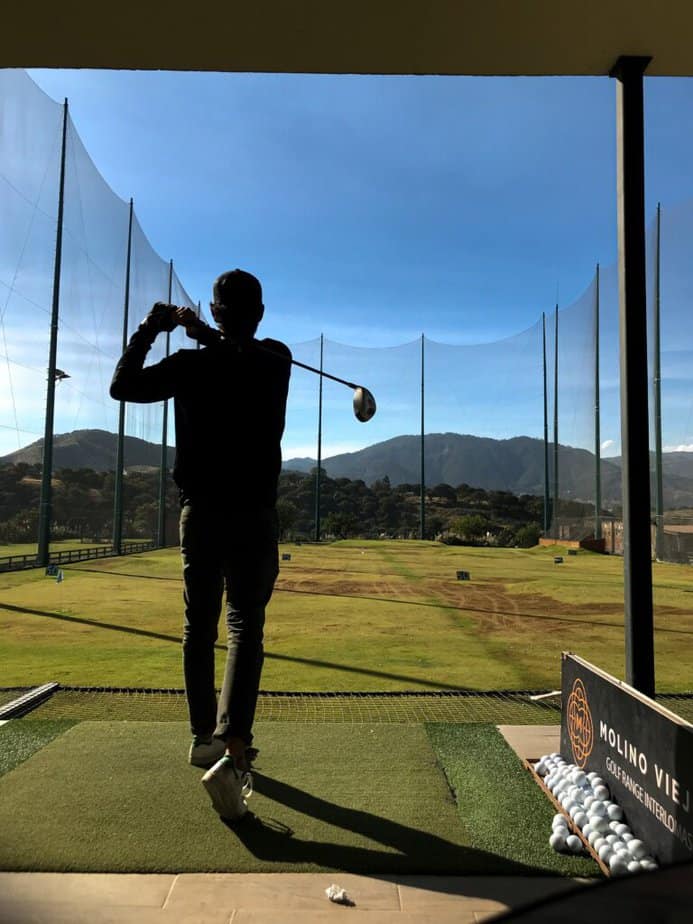
Golf How Do You Start Playing Golf for the First Time?
Here’s where you can start.
- Start taking lessons. The best option is to contact a PGA professional. Golf tips from experienced instructors will allow you to quickly and effectively translate theory into practicing a good game.
- You need to learn short shots. Approximately half of your strokes are within 50 yards of the green. This means that half of your practice time should be devoted to wedges and putters. These are the kinds of strokes you can further hone at home, as other golfers do. You can practice your short game in your backyard or your room, ideally with a golf simulator so you can calculate your progress in terms of scores.
- Get a workout on the driving range. Warm up your golf muscles with half-swings before hitting one of your wedges or short irons. After that, lengthen and quicken your strokes before switching to your middle irons. Work your way up to the driver, then switch back to iron shots or wedges after you have practiced with them. You may control your tempo and tension level by doing this.
- After some initial practice on the driving range, you will be able to decide which golf clubs you need. You can then purchase a basic set of clubs.
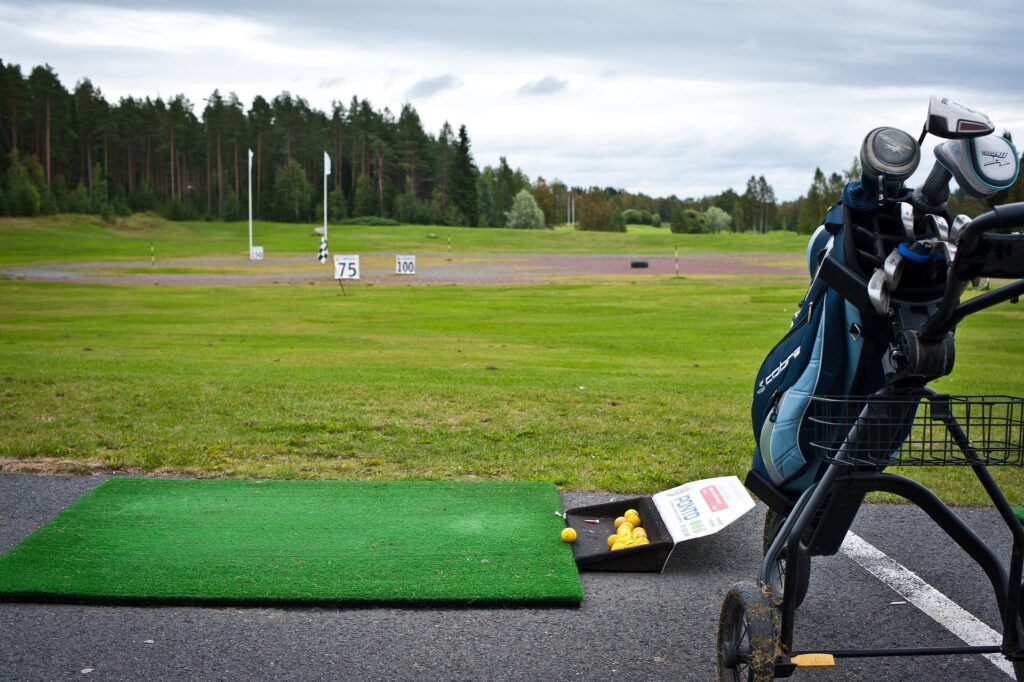
Learning How To Play Golf
The first question beginners have: “Where can we play and practice golf?”
The best places to learn golf are driving ranges and 9-hole pitch-and-putt courses. The 18-hole courses are best if you already have some minimal skills.
You can rent equipment such as golf balls and clubs. Before heading out to the golf course, it’s a good idea to have your first practice here. The driving range is a great place to practice proper golf-hitting techniques.
Once you feel more confident in golf, you can move on to the local 9-hole short course or pitch and putt course. The short holes of this course eliminate the need to hit the golf ball 300 yards and allow you to learn the basics of chipping and putting.
Success for a novice golfer on the driving range does not guarantee great results on the golf course. When a player finds himself on the golf course, he faces real obstacles. Each hole has a specially designed landscape with a unique set of traps (water bodies, sand traps, etc.). Therefore, the golfer has to display strategic skills, as no two holes are the same on any course in the world. This differentiates golf from other sports where a standardized playing surface is usually used.
For a beginner, the ideal course should be flat, short, and without a lot of obstacles that you will have to overcome to get to the fairway.
After clearly improving your game on the 9-hole pitch and putt courses, you can move on to the next level of difficulty, which is a full 18-hole course. To maximize the fun and interest of the game, it is best to treat the first rounds of play as a learning experience (you don’t need to record all the scores on your scorecard). To begin with, hit the ball, find it, and hit it again. In this way, step by step, after practicing your club skills, move on to the next hole.
This approach to the game will allow you and your playing partners to move freely around the course from hole to hole without waiting for perfect strokes. This will allow all to have a great rest, and maximize their learning of the course and shot trajectories. And even if you play poorly, you will still have a good time outdoors in pleasant company.
How Do You Play Golf: Golf Swing Setup
To start playing golf, you not only need to go out on the course, know the rules of the game, and have the necessary equipment for the game but most importantly, you need to know how to use a golf club and make the necessary shots.
The golf swing depends on the placement of the arms and body when swinging the golf club. With the correct positioning of the arms and body when swinging the club, it is much easier to hit a successful shot.
6 Steps to a Successful Golf Swing
1. Posture
Proper posture is a major factor in the effectiveness of your club swing. Golf swing posture is different from baseball swing posture, so you should bend your hips forward and not bend your knees too much. This will allow you to make an accurate hit on the ball.
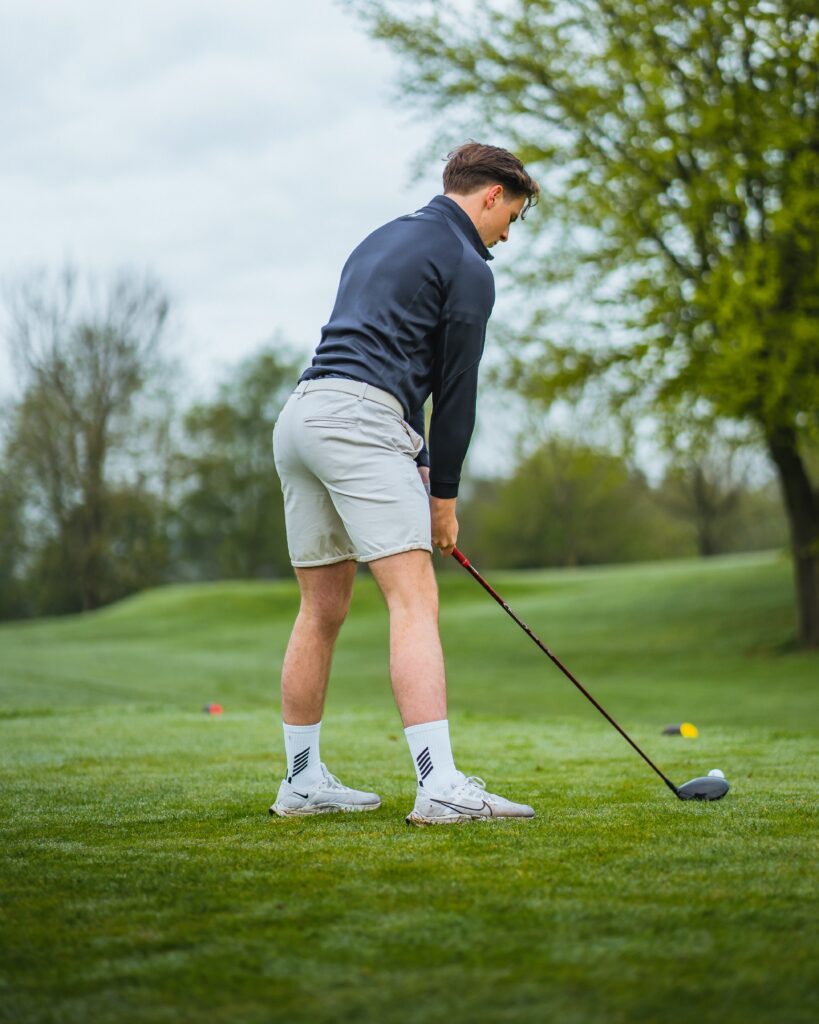
2. Body Positioning And Golf Grip
First, spread your feet hip-width apart, with your knees and hips slightly bent. The distribution of weight should be even between the centers of the feet. This body posture will allow you to hold the golf club so that it touches the ground where you will hit the golf ball. The most common mistake many golfers make is having a weak grip, which results in a loss of hitting power. Therefore, do it right away:
- First, you wrap the fingers of your non-dominant hand around the golf club handle (this is not the hand you will be swinging with);
- then put your dominant hand underneath. Eventually, your hands should be intertwined with each other, and the grip on the golf club should feel like it’s mostly in your fingers.
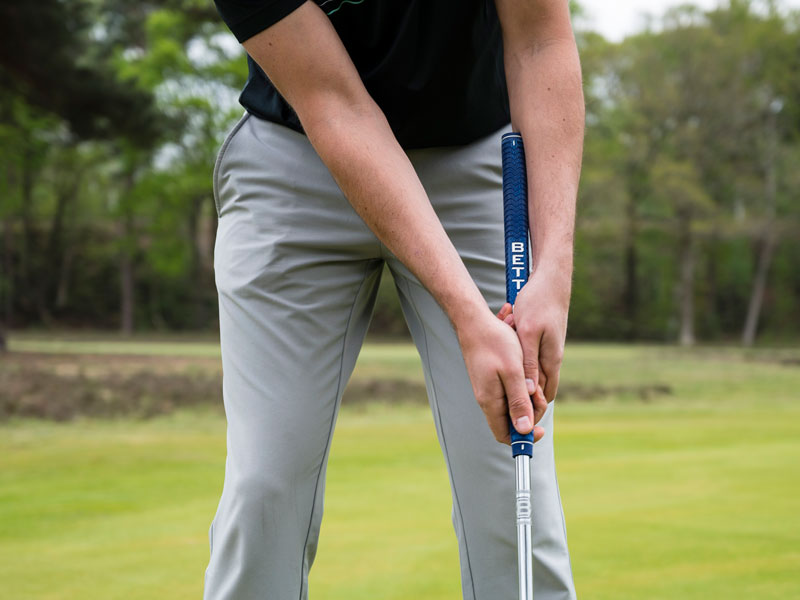
So you have adopted a balanced athletic stance, with the golf ball in the center of the clubface. From this point on, all you have to do is keep your balance until the end of your golf shot to hit the middle of the clubface more often.
3. Start The Swing
When swinging, the club is lifted from the starting position and put behind the head. Try to rotate your body as you swing. You should feel your shoulders in an upward rotation, and more weight on your dominant hip.
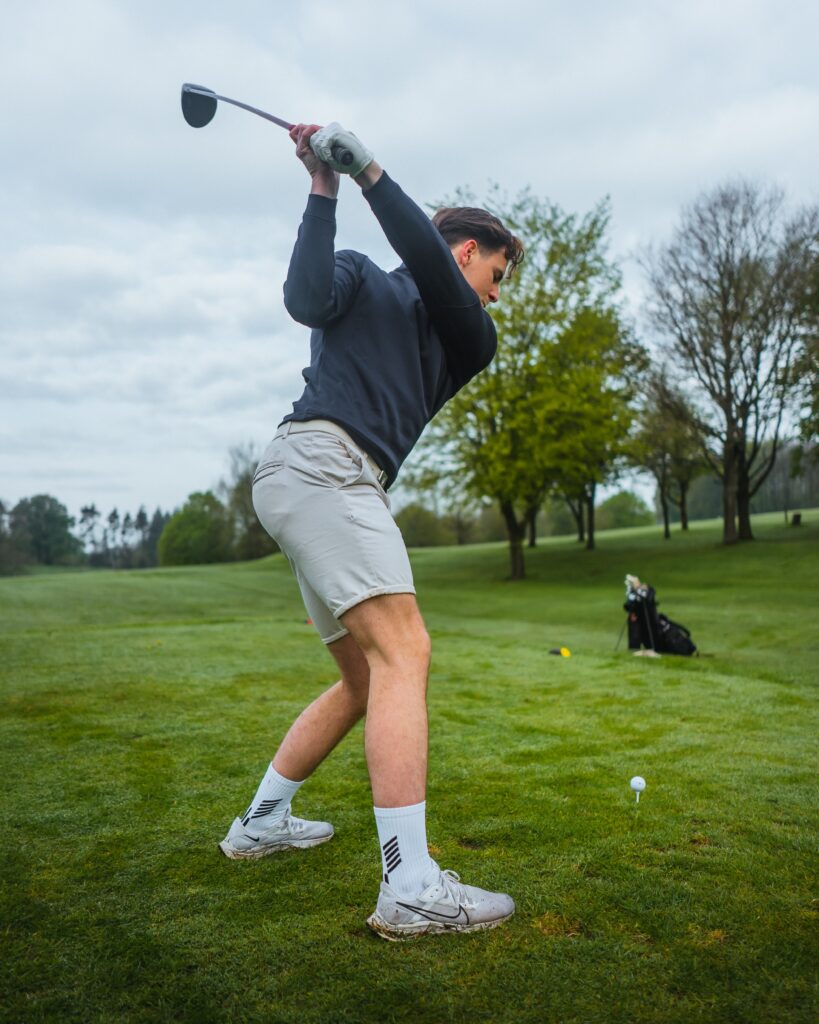
4. Control The Flight Of The Golf Ball
The shaft of the club should be pointing at the target at the time of impact. Do not hit with your hands alone. To increase the energy of your swing, you should add hip movement.
5. Be Sure To Follow Through With The Swing
Keep your eyes on the ball as you swing and hit it. Do not raise your head immediately after the shot to avoid losing your aiming accuracy. If the shot itself is taken correctly, you should also finish it in a certain position. The belt buckle will be facing the target, the golf club will be behind your back, and the main body mass will be transferred to the leg closest to the target, the other leg on the toe
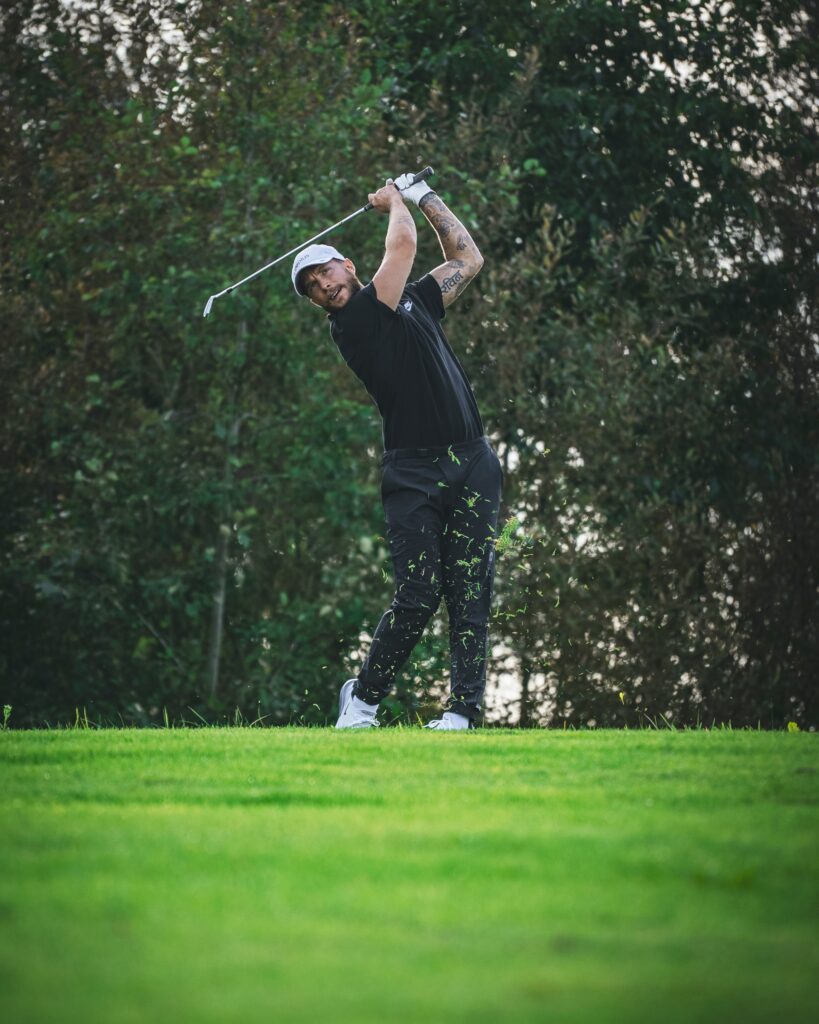
6. Powerful Shot
Swing your club smoothly and focus on hitting a powerful shot. To do this, you should practice shooting from the center of the golf club. If a shot is made from the center of the club, the ball can fly a long distance. Distance is rarely an issue when you are in the center of the club (the golden spot).
Basic Shots You Should Know
On your iron shots, you should lower your strike. Many new golfers struggle with this; they attempt to assist all of their shots into the air, but this is incorrect. In order for the loft to assist in lifting the golf ball into the air, irons, and wedges are made to strike the ball deeply.
Your strokes should be more powerful and rotational, and at this shot, the ball is compressed downward and leaves a small depression in the grass.
To lift the ball into the air, hit downward. Drivers and fairway woods with a lower elevation are designed for hitting the ball off the tee or ground.
Short Game: Chip And Pitch
As you get closer to the green (about 15 yards from the green), you will need to take smaller swings to control your shot distance. The chipping swing is a short swing of the club back and forth. You also need to understand the difference between chip and pitch.
When you hit short shots on the green, you must choose a chip or pitch. Use the chip when there is a lot of green between you and the hole and no additional obstacles. Use the pitch when you need to overcome obstacles (bunkers or deep rough) or stop the ball faster. The extra height on this shot allows the ball to land faster and softer.
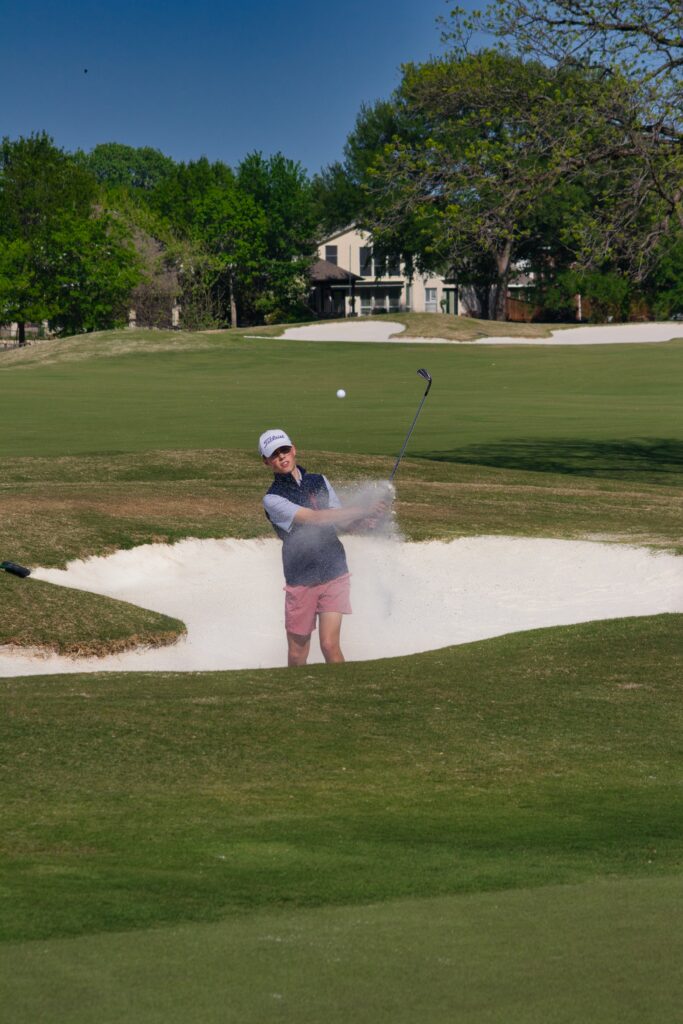
How To Get Out Of The Bunker?
When hitting from the side bunker, the club does not hit the ball but the sand behind the ball, so the sand can push the club head out. Because the sand slows the club down, you will have to swing harder than usual.
When using the “sand wedge,” you should stand so that the ball is level with the toe of your front foot. Then turn your feet for stability and concentrate on standing about two inches behind the ball. Rotate the club back about halfway through the stroke, then lower it to the point where the ball is hit. Continue to rotate your torso at the finish line so that your chest is facing the target.

When honing your golf shots, you shouldn’t forget the most important thing in this game – and that’s good fitness. A stable back, strong thigh muscles, and flexible hamstrings help golfers become world-class professionals. Regular drills at home or at the gym will help keep your body in good shape.
It is also best to arrive at the course 45-60 minutes prior to their tee time. This is enough time to warm up, stretch, and prepare your body for the game.

The Secret To The Perfect Golf Swing
Since the purpose of our blog is to tell the whole truth about golf, we will inform you about the secret that will help you practice swings. A good golf game is about swinging well, but the standard setup when it comes to hitting technique doesn’t always work. Here’s why.
Mastering the classic golf swing technique is quite a complex action that takes lots of time. This technique requires a great deal of psychological stability, which is why its effectiveness decreases catastrophically with age and the loss of high physical fitness in even the great golfer. Unfortunately, the classic golf swing technique only works for most golfers who started practicing golf as children.
However, the good news is that as you play, you can find and develop your correct and ideal swing because you need to look within rather than outside for answers. In other words, believe in yourself, and you can find your perfect swing in this hard game.
Another challenge that many golfers face who play on the classic system. Grip and club aiming are not universal across different clubs. The inconsistency of the stance and grip of the club that the golfer is holding results in a lot of difficulties for classic golfers when playing the 4th, 3rd, and, of course, the 2nd and 1st irons and driver.
The fact is that many golfers improve their handicaps by playing with only one club. The secret of such successful rounds is simple – it is much easier to “set up” a swing on one or three clubs than on all 14 clubs.
Thus, to play successful golf, you must customize your grip and stance for each club if you want to play a set of clubs. At first glance, this may seem complicated. However, if you initially learn the correct body position and grip in golf, the adjustment will happen automatically with each new club, just by looking at the club and holding it in your hands.
Golf Equipment For Beginners
As mentioned, players can use no more than 14 clubs per round. In addition to clubs and a golf ball, players usually wear a glove on their non-dominant hand and use tees and small pegs for the first shot on any hole.
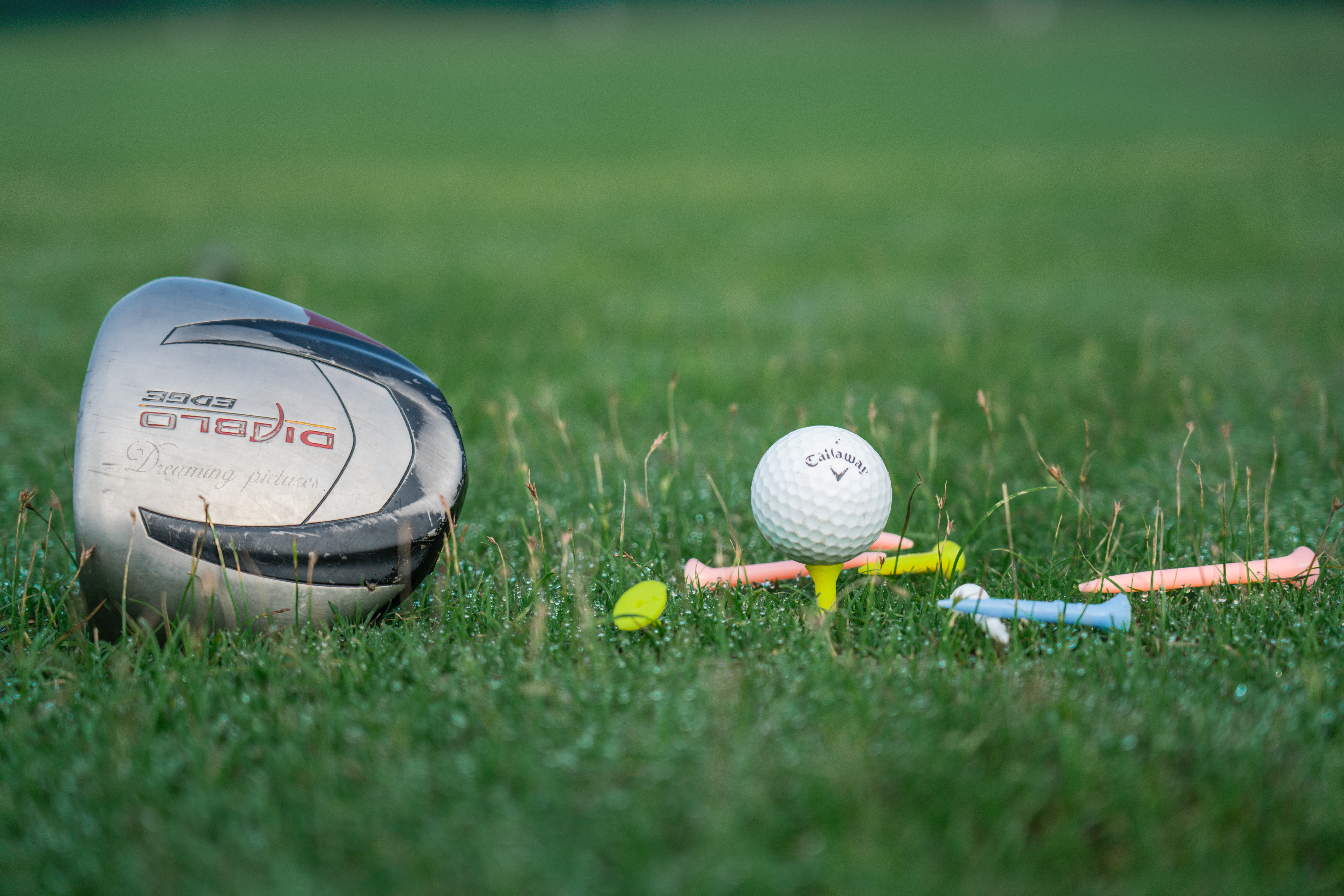
The equipment used in golf is highly regulated. Everything is important here: the make and model of clubs allowed, the shape of the grooves on their face (the surface on which the ball strikes), the exact weight, and the aerodynamic capabilities of the golf balls.
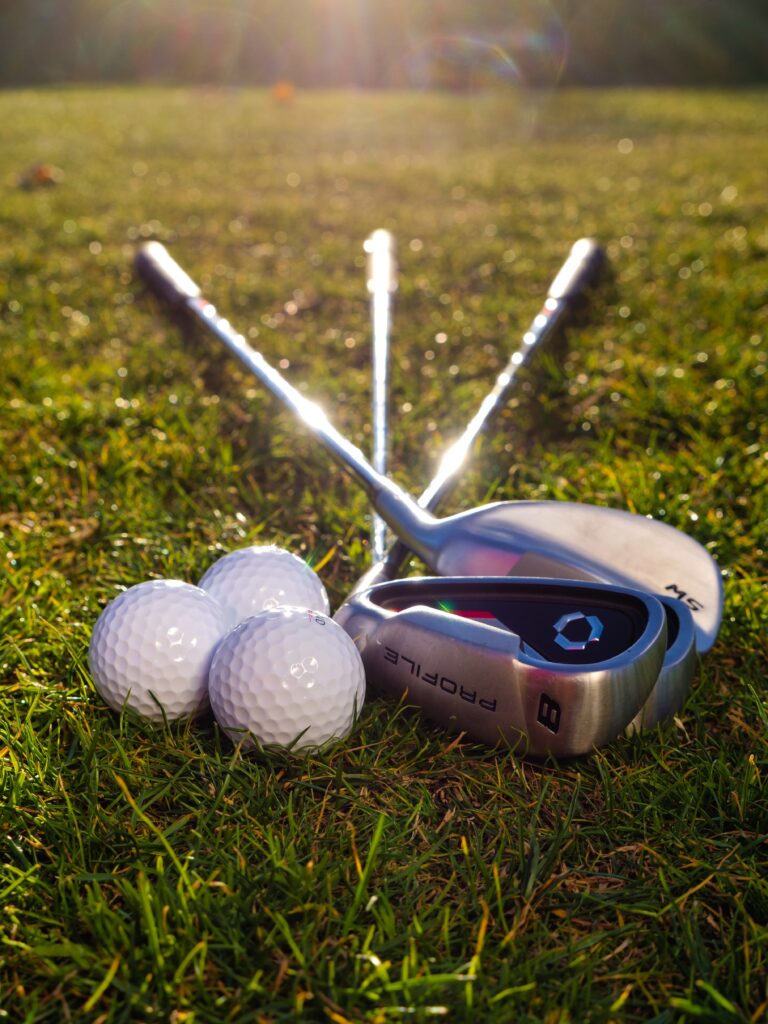
What Are The Best Clubs For Beginners?
The standard set includes 14 clubs: driver, 3 iron, 4 iron, 4 iron, 5 iron, 6 iron, 7 iron, 8 iron, 9 iron, 3 wood, 5 wood, sand wedge, pitching wedge, lob wedge, and putter. You don’t need a full set of 14 clubs at first. To get started, it’s best to focus on improving your swing and shot with minimal effort. The main thing is to find a place where you can swing your full swing.
You can start by buying beginner’s clubs. And you can even start not with new clubs. Beginner club sets contain all the clubs you need and often include a club bag. You can be sure the clubs will be constructed with forgiveness in mind if you get a set designed for novices.
Different clubs travel different distances and are used in different situations on the golf course. For example, for your first shot on most holes, you will use a driver (the longest club in your bag). With a golf tee, you can lift the ball high and then take a strong swing with the driver.
If you are a beginner golfer, it is easiest to choose woods with more height for practicing. With such a club, the ball will rise into the air more easily and fly more straight. Therefore, choose drivers with an elevation angle of at least 10 degrees and fairway woods with an elevation angle of 17 degrees rather than 15 degrees.
For beginners, hybrids will be preferred over 3-, 4-, and 5-irons. Irons with wider soles reduce the likelihood of the club hitting the ground at impact too far behind the ball. In addition, the iron’s center of gravity will be lower because the weight will be concentrated in the sole, making it easier for the ball to fly on a higher trajectory.
These golf clubs are suitable for beginning golf practice:
- putter,
- driver, sand wedge (loft 54-56 degrees),
- pitching wedge,
- 6-iron,
- 8-iron,
- and fairway wood/hybrid (loft 18-21 degrees).
How Do You Choose Golf Balls?
During your first workouts at home in your backyard or in a field near you, plastic balls will even work for you. If you’ve already started playing golf and notice that you’re losing more than two balls per round, start by buying a set of a dozen balls for $20.

Over time, when you don’t lose balls as often, you can upgrade to more expensive sets of balls. Of course, each brand of ball has its own characteristics. Expensive balls have multiple layers. This intricate design allows the ball to fly longer when hit with a driver and spin harder when hit with a wedge or iron. How to choose the right golf balls, advantages and disadvantages of different ball models are collected in one guide.
Golf Clothes
Sometimes novice golfers get too wrapped up in golf etiquette and pay excessive attention to how to dress appropriately for a game or tournament. Let’s not forget that it’s just a game. However, it is possible to follow some simple, basic guidelines for golf attire, as most golf courses have a certain dress code.
It is better to give up jeans immediately: even if the rules of the course allow such a form of clothing, it will be uncomfortable to play golf. A collared shirt (golf shirt) and shorts or pants will look appropriate on the golf course. It is not necessary for women to wear this type of shirt. Shirts with a collar can be made of cotton or technical fabrics, suitable for hot weather.

Start with sneakers that you can go to the golf course or a pitch-and-putt golf course in. However, on full courses, you’ll already need golf shoes. Golf shoes have small spikes on the sole, which ensure that the player has good contact with the ground without slipping, even if the weather is wet and the ground becomes damp. The spikes in golf shoes are flexible, allowing them to bend and twist as the player moves during swings.
Complete the look with a baseball cap and quality sunglasses. They will protect you from the bright sun.
Learning the Basic Golf Rules
The official rules of golf take up about 100 pages in a booklet published by the USGA and R&A. It is impossible to memorize all the rules of golf at once, but you can always refer to more experienced players when playing golf. Let’s look at the main points of the game that every golfer faces.
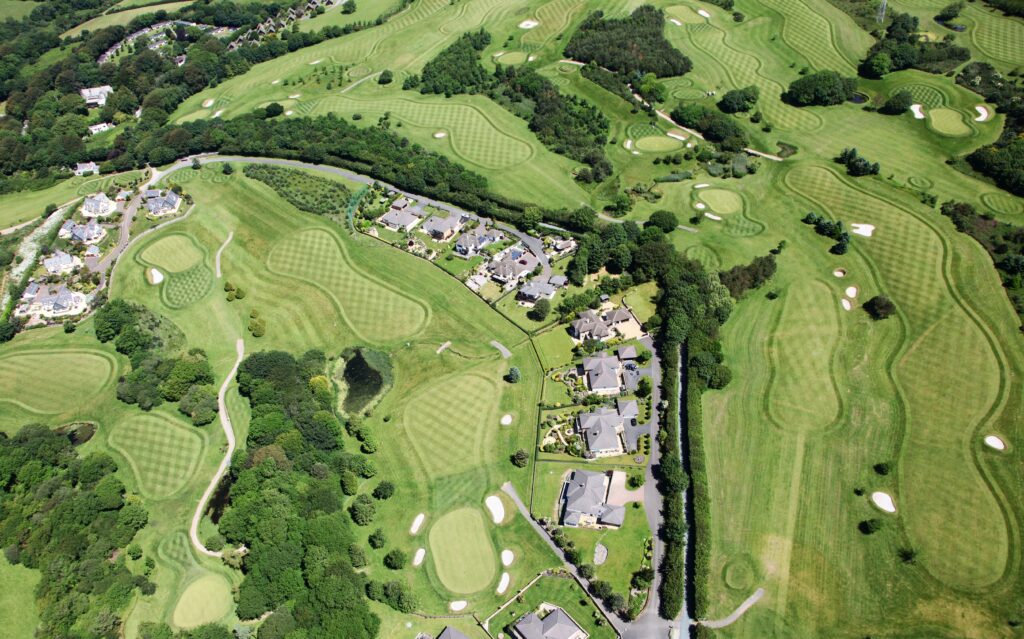
Standard Course
A “hole” in golf refers to the physical hole marked by a flag into which the ball must be driven and the entire area from tee to green.
Each golf course consists of 18 holes, the first nine of which are considered the front nine and the remaining nine the back nine. There are also golf courses with 9 holes, in which case players go through the course again to make up a round of 18 holes.
Every hole has a distinct length and its own topography. The majority of the stretch is covered with a lawn of grass and is called the rough. The green, or fairway, is a designated area that is located close to the hole. This is where the short grass, called the putting green, is level.
The terrain of a golf course usually includes many hazard obstacles – water, bumps, sand traps (called bunkers), and trees – designed to make the game difficult. Different distances between holes also increase the difficulty of the game.
Play on each hole begins at the tee area, where players tee off or drive the ball into the fairway. At the end of the hole area, which can vary in length from 150 to 600 yards, is the “green” area surrounding the hole proper, or the cup, into which the golf ball must be driven to complete the hole.
How Do You Win at Golf?
Most professional competitions, including all four Majors, use a stroke play system. Four rounds are played over four days. The winner is the player who completes 72 holes (four rounds of 18 holes, usually on the same course) with the fewest number of golf shots.

Rules Of The Game
Golf is played by groups of two to four people moving around the golf course together. Each participant takes turns playing with his or her own ball. The ball must be played from where it lies, except in unusual cases where the rules allow the ball to be moved to a slightly better position.
In a stroke competition, the total number of strokes used to move the ball from and to the hole is recorded as the player’s score for that individual hole. The player who uses as few shots as possible to complete the course is the winner. In match play, scores are compared after each hole, and the player wins, loses, or splits (tied game) each hole.
If we talk about a professional golf tournament, it consists of 80-160 players playing in groups of 3-4 people, competing against each other. Among team tournaments, the most significant is the Ryder Cup, played between Europe and the United States. 12 players from each side compete in singles matches, playing one against one, and doubles matches, playing two against two.
What should I pay attention to while playing golf?
- Pace of play. First, pay attention to your pace of play, because no one likes to wait on the course because of slow play.
Even when you learn how to play golf, you will have to hit more strokes than experienced players at first. However, you don’t have to hold up your group or the course, so keep a decent pace.
Prepare yourself before the strike. Just one practice swing is necessary before you strike the ball. Pick up and take the highest possible score if you are having trouble with a hole.
- The main objective of the game. In golf, the most important thing is to get the ball from the starting point, or tee, onto the green and into the hole. The hole is flagged, and you must hit the ball into it with as few strokes as possible.
- Play the course in the order of holes. As each golf course has its own structure, it is best to have a course map with you or to travel around with a person or group who is familiar with the course.
- Order of play. Generally, the player with the best score on the last hole starts first, the next best score goes next, etc. The traditional rule is that the player furthest from the hole should hit, but sometimes golfers agree to play “ready golf”. This means that whoever is ready to hit the shot at that moment.
- Putting green. On the putting green, a player may pick up, remove, and mark his ball if the ball is returned to the same place it was. Also, a player may repair a golf ball mark, but not spike marks that are on the hitting line.
- Do not move the ball around the golf course. If a golf ball lands in an unlucky spot, the rules of the game prohibit picking up the ball and carrying it to another spot unless it is obstructed by an artificial obstacle (yardage marker or tin can). The player must take a club shot at the ball. Players are not allowed to change their surroundings, such as by breaking branches, clearing debris, or moving sand, to increase their chances of getting out of a difficult situation. If the ball is lost and cannot be saved, a new ball is used to continue play.
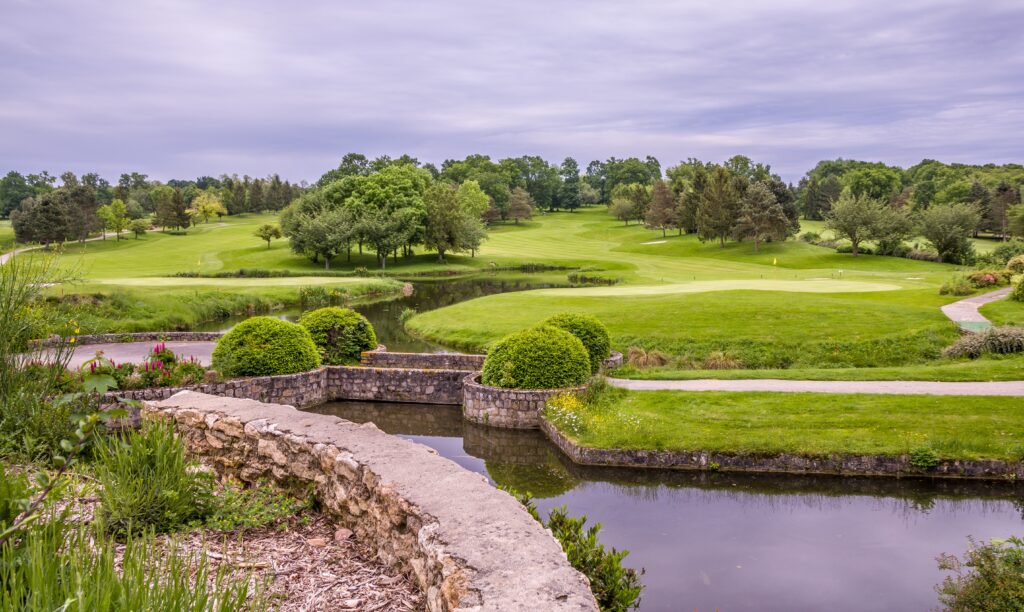
Balls that are lost include those that are hit into water hazards or beyond of bounds (off that particular hole). The penalty is one stroke. It’s interesting to note that if a player’s ball enters a water hazard during a shot, they may choose to continue playing without incurring a penalty, but in most circumstances, this is not practical, and they must instead incur a distance and stroke penalty before restarting play with a new ball.
- The number of clubs in a golf bag must not exceed 14. The change of clubs is allowed only after the end of each round.
- Keep score for each hole. More on this in the next section.
How Do You Score Golf?
You should know how the scoring works, right? In golf, the scoring is a bit unusual, because the fewer points you have, the better, and the winner is the one who has the lowest score in the end. Points are awarded for each stroke of the club on the golf ball, which means that the one who hits all the holes in the least number of strokes wins.
Each hole on the course has a predetermined par for each hole. Each hole has a certain (ideal) number of strokes allotted to it, which are called “Par”. Each time you hit the ball, it counts as a “1” in the scoring. Par ranges from 3 to 5, and each hole on the course will be called “Par 3”, “Par 4” or “Par 5”. If the Par is 3 and it took you 4 strokes to drive the ball into the hole, your score will be +1. If the Par for all holes is 80 strokes and you make 95, your score will be +15.
To fully understand how the score is kept, you need to familiarize yourself with a few golf terms:
- Par
Par is the number of strokes that a player needs to pass a given area and hit the hole. If a player hits a par, he gets 0 points. Some players may decide in advance that they are not allowed more than two extra strokes per Par. - Bogey, double bogey
Bogey means that there were more strokes than pars. There are double bogey, triple bogey, and so on. A +1 point is given for each bogey. - Birdie
Birdie means it took one stroke less than par. -1 point. - Eagle
Eagle – It took two less strokes. -2 points. - Double Eagle/Albatross
Double eagle/albatross – Three strokes less per hole and -3 points, respectively. - Hole in one
Hole in one – The golfer sinks the ball into the hole with one stroke (the score is based on par).
You must have a scoring card in your hand. In one round of golf, a golfer should typically complete 18 holes. You must write down the score on this card after each hole. Without it, it is even possible to make a mistake in scoring. Keep track of both your score and the score of the other playing partners in your group.
- Generally, you are responsible for scoring your opponent’s score, and your opponent should be scoring yours. After each round, you should check each other’s cards to see if the score is recorded correctly. Otherwise, if your opponent makes an accidental mistake that worsens your score, you will have to agree to it at the end of the game.
- Another scoring option. Players can choose one person before the game starts to keep the score for all players.
Conclusion
So, we have given detailed instructions on how to start playing the truly greatest game, step by step. We hope that our guide was helpful. Please leave your comments about what you think about the game and how to learn to play it. If you still have additional questions, please do not hesitate to ask.
So, right now, you can get closer to golf: you can find a driving range or a 9-hole course; you can sign up with a professional for group or individual lessons. Most importantly, remember that all the answers are within us, so maybe you can be a golf pioneer by applying your own swing and stroke technique. Be sure to read good golf books and study examples of the greatest golfers.
